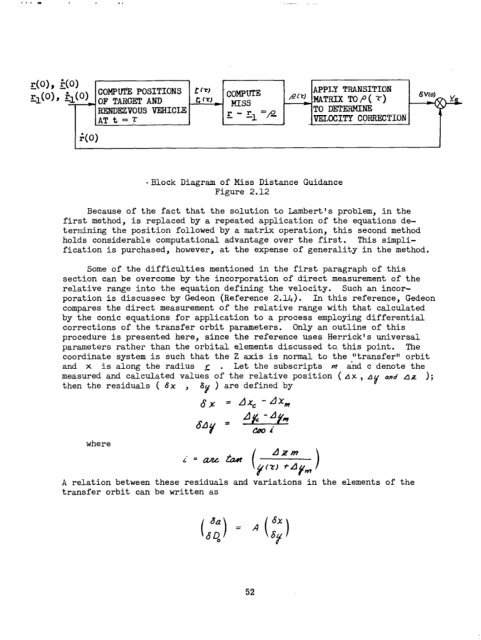guidance, flight mechanics and trajectory optimization
guidance, flight mechanics and trajectory optimization
guidance, flight mechanics and trajectory optimization
Create successful ePaper yourself
Turn your PDF publications into a flip-book with our unique Google optimized e-Paper software.
I(7)<br />
I<br />
COMPUTE<br />
c (7)<br />
=- MISS<br />
g-r -1 =P-<br />
*Block Diagram of Miss Distance Guidance<br />
Figure 2.12<br />
APPLY TRANSITION<br />
EtrCMATRIX TOP(r)<br />
TO DEEIERMINE<br />
VELOCITY C@RECTION<br />
Because of the fact that the solution to Lambert's problem, in the<br />
first method, is replaced by a repeated application of the equations de-<br />
termining the position followed by a matrix operation, this second method<br />
holds considerable computational advantage over the first. This simpli-<br />
fication is purchased, however, at the expense of generality in the method.<br />
Some of the difficulties mentioned in the first paragraph of this<br />
section can be overcome by the incorporation of direct measurement of the<br />
relative range into the equation defining the velocity. Such an incor-<br />
poration is discussec by Gedeon (Reference 2.14). In this reference, Gedeon<br />
compares the direct measurement of the relative range with that calculated<br />
by the conic equations for application to a process employing differential<br />
corrections of the transfer orbit parameters. Only an outline of this<br />
procedure is presented here, since the reference uses Herrick's universal<br />
parameters rather than the orbital elements discussed to this point. The<br />
coordinate system is such that the 2 axis is normal to the "transfer" orbit<br />
<strong>and</strong> x is along the radius r . Let the subscripts m <strong>and</strong> c denote the<br />
measured <strong>and</strong> calculated values of the relative position ( AX, AY <strong>and</strong> 4~ );<br />
then the residuals ( 6x , 8~ ) are defined by<br />
where<br />
6x = Ax, -Ax,<br />
A relation between these residuals <strong>and</strong> variations in the elements of the<br />
transfer orbit can be written as<br />
52
















